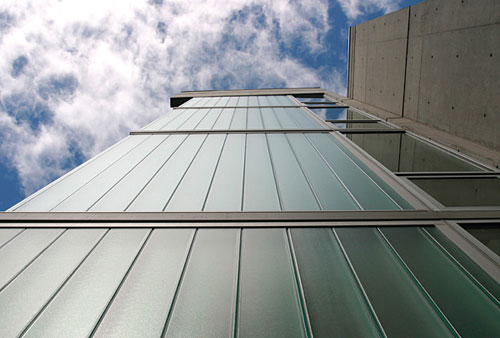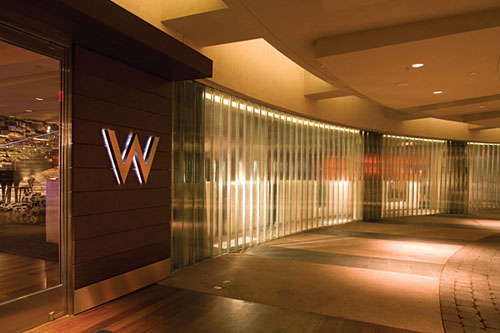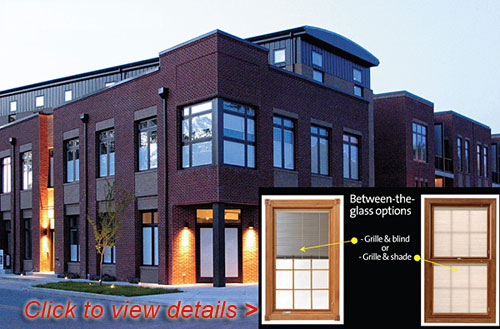Daylight Savings: Window Systems Deliver Light and Reduced Energy Costs
Options in Glass
In the quest for a distinctive aesthetic, architects seek out different types of glass products. "Design
professionals are increasingly seeking alternatives to window glass and glass block, and, among these, channel glass is one unique product we're seeing specified in daylighting designs for both hot and cold climates," says TGP's Razwick.
 |
Channel glass is composed of linear cast-glass channels. Photo courtesy of Technical Glass Products (TGP) |
Â
Channel glass is composed of long, narrow "U"-shaped linear cast-glass channels. It is suitable for daylighting because the glazing can be installed vertically or horizontally with an extruded metal frame around the perimeter, enabling uninterrupted vertical spans of up to 23 feet. Manufacturers offer the glass in a range of colors and textures with varying translucency, allowing for the passage of natural light without loss of privacy, and with either tempering or filming options available to meet impact safety requirements. Channel glass provides warm, diffuse light for interior spaces and, because of its shape, the glazing system can achieve very tight radiuses or can be used in curving or serpentine applications. Intermediate vertical mullions are generally not required for vertical installations. Additional benefits include adaptability to seismic code requirements.
For the Scottsdale W Hotel and Residences, Starwood's first W Hotel in Arizona, San Francisco-based Hornberger + Worstell Architects were tasked with creating a state-of-the-art hotel living room, a signature feature of W Hotels worldwide. A key design challenge was creating a space that flows well from the porte cochere entry and incorporates natural light while keeping out the Arizona heat, which often hovers above 100 ºF.
"We wanted to find a contemporary looking translucent material without a metal frame to create a pattern of glazing and diffuse the light in interesting and changeable ways throughout the day and night," says Christian Low, AIA, ANZIA, principal and senior vice president of Hornberger + Worstell Architects. "We also wanted some transparency, but not a clear fish bowl glass effect, because we were trying to visually invite the guests into the hotel lobby living room, yet also screen the cars and activities outside in the porte cochere."
For a panoramic view uninterrupted by framing, channel glass was used to create an approximately 100-foot-long, 10-foot-high curved glass wall running the length of the lobby. The glass was installed in two overlapping layers, creating an air pocket in between that diffuses the light when it enters and also provides a thermal and acoustic gap. "Channel glass allows for natural daylighting, yet provides filtered and tempered light via the air space and the depth of the glass," states Low. "The W Scottsdale project was required by building code to meet a very high level of energy efficiency to deal with the extreme high and low temperatures of the desert. The channel glass definitely helps with that. And at night, with the indirect lighting of the channel glass wall we anticipate a variety of color and the movement of people to create warmth and activation."
To further enhance energy performance, designers can specify thermally broken frames to reduce heat bridging, and fill the gap between the glass channels with an insulating material known as aerogel, one of the lightest and lowest density solids in existence. Made from a gel in which the liquid component has been replaced by gas, aerogel is noted for its effectiveness as a thermal insulator. It is 90 percent air, and therefore translucent, and brings the U value of the glass from an uninsulated value of .49 to a value of .21, with a corresponding drop in solar heat gain coefficient from .69 to .31.
Aerogel was called in after the fact at the John C. Lincoln Hospital in Phoenix where the emergency room's westward facing wall was made entirely of channel glass. The Arizona sun created an oppressive heat gain in the emergency waiting room, necessitating higher energy costs. The dual-glazed channel glass was filled with aerogel insulation, with anecdotal reports indicating improvements in comfort and air conditioning costs.
Shades and Blinds
While many architects seek to achieve daylighting goals entirely through glass itself, shading systems can also be effective solutions for managing heat and glare. "It's always best to stop solar heat gain before it enters the building," says Pella's Zeimetz. "Shading strategies on the exterior of the building, as in window setbacks or sunshades, are most effective. But they can also be expensive. Sandwiching shades or blinds between panes of window glass are a close second in terms of reducing solar heat gain because they stop the heat before it gets through the inner piece of glass. They are also less expensive than exterior shading solutions. The least effective strategy is to allow the heat to pass through both panes of glass into the building. Then you have to use air-conditioning to remove the heat gain."
 |
A curved channel glass wall graces the atrium at Scottsdale's W Hotel. Photo courtesy of Technical Glass Products (TGP) |
Â
Between-the-glass blinds can be raised, lowered, and tilted to control daylight and glare. When fully open, the blinds act like miniature light shelves to reflect light toward the ceiling. When fully closed, between-the-glass blinds offer a 43 percent reduction in solar heat gain when compared to conventional room-side blinds according to the2005 ASHRAE Fundamentals Handbook. Unlike conventional room-side window treatments, between-the-glass options, available in various levels of transparency, translucency, and opacity, are less prone to damage and dust, preventing additional maintenance and replacement costs while contributing to better indoor air quality. Recent research conducted by the Department of Occupational and Environmental Health at the University of Iowa found windows with ordinary room-side blinds accumulate 200 times more of certain airborne allergens than between-the-glass blinds.
Between-the-glass products, which have no room side cords, have wide applicability in environments where minimizing janitorial maintenance and safety concerns are key, such as schools and hospitals. They've also been featured in multi-family projects that are high-end and green, such as Morgan Park Place in Nashville, Tennessee, which was awarded the 2007 Tennessee Governor's Environmental Stewardship Award recognizing excellence in sustainable building and is Tennessee's first to be certified by EarthCraft, a voluntary program that provides a model for building comfortable, durable, energy-efficient homes. Architects Dryden Abernathy Architecture Design specified between-the-glass products with a choice of blinds, shades, grilles or decorative panels, facilitating cleaning and maintenance and protection from dust and damage. "When you have a premium product on the marketplace, you have to offer advantages - especially when it is a small space," says Darrell Crawford of New Urban Construction. "Our customers want personalization and the windows help meet that need."

|
Between-the-glass shades or blinds maximize daylight control while reducing heat gain at Morgan Park Place in Nashville. Morgan Park Place, Nashville,TN; Dryden Abernathy Architecture Design; Courtesy of Pella Corporation |
Â
For large-scale institutional or corporate installations, motorized shades that use software-based control systems designed to automatically adjust shade position incrementally to the angle and position of the sun, have achieved reduction in buildings' lighting energy costs of up to 70 percent. Designed to protect interiors from direct sun, excessive brightness and glare, some automated shade systems work with the dynamics of the sun to filter the radiant component of sunlight out. Data from roof mounted radiometers are fed to the computer to determine momentary microclimatic conditions such as sunny, cloudy or bright-overcast sky conditions and on a predetermined hourly or daily schedule, automatically position the shade to meet varying sun angles. The premise is to maximize natural light and view by keeping the shade as high up as possible but not letting the sun breach a defined zone determined by the user. Solar tracking systems are designed to operate on a stand-alone basis, but also can be integrated with building management systems for life safety purposes for example. They are also available with overrides for shadow and brightness, that is, if the brightness on the glass exceeds specified levels, the brightness override automatically lowers shades to the appropriate position to mitigate the excess brightness.









